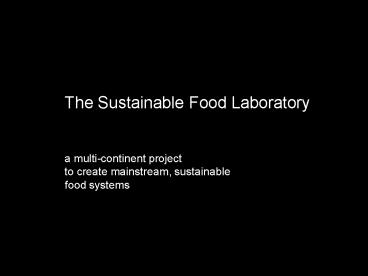Food Lab Presentation - PowerPoint PPT Presentation
1 / 65
Title: Food Lab Presentation
1
The Sustainable Food Laboratory a
multi-continent project to create mainstream,
sustainable food systems
2
(No Transcript)
3
1950 2. 5 billion people
4
2000 6 billion people
5
2050 9.2 billion people
6
Agriculture the largest industry on the
planet. 1.3 billion people. 1.3 trillion in
farm revenue.
7
Half the habitable land on earth is farmed.
Half the habitable land on earth is farmed.
8
70 of fresh water is used for crops or livestock.
9
With inputs of nitrogenous fertilizer, global
food production has kept pace with population
growth.
10
But....
11
800 million people are seriously underfed.
800 million people are seriously underfed.
12
Half of the worlds hungry people live or work
on farms.
13
Displacement from farms has contributed to the
global slum population of 1 billion people.
14
Our food system produces inexpensive food for the
rich and expensive food for the poor.
Our food system produces inexpensive food for the
rich and expensive food for the poor.
15
A cyclical pattern of rising production and
falling prices has ruined farms and farmers.
change in number of farm enterprises, European
Union 1982-1993
UK
NL
Italy
Spain
Finland
Austria
Greece
Sweden
Belgium
Denmark
Germany
Luxemborg
France
Ireland
source FAO
16
Fisheries around the world are being pushed to
the point of collapse.
Atlantic cod catch Newfoundland
1950
2000
17
Fossil fuels used to grow and distribute food
are a contributing factor in global warming.
18
Consumers and businesses want more organic, fair
trade, and sustainably produced and packaged
foods.
19
one example commodities
20
The top 8 commodities, such as corn, wheat, soy
and rice, provide more than 80 of human
calories.
21
All commodities have followed the same basic
pattern.
prices
yields
22
These patterns put more marginal land into
production -- and increase the use of chemicals,
fossil fuels, and water.
Global Fertilizer Use
1950
2000
23
Since 1945, severe or extreme soil degradation
has affected an area larger than India and China.
24
a second example retail specifications
25
Purchase specifications that seek desirable
goals such as quality, traceability, and
environmental compliance...
26
coupled with fierce competition to offer the
lowest price...
27
and the consolidation of retail into a small
number of very large buyers...
Really Big Market
28
have contributed to a crisis in rural poverty in
both developed and developing nations.
29
How do we turn things around?
30
together
31
(No Transcript)
32
vision
33
The ability of farmers and farm workers to earn a
decent living.
34
Increasing soil fertility.
35
Abundant, clean water.
36
Preservation of biodiversity.
37
Protection of fragile fisheries.
Protection of fragile fisheries.
38
Energy production, consumption, and emissions
that the world can sustain forever.
39
Enough food production to meet growing needs.
40
Profitable businesses.
41
process
42
The success of an intervention depends on the
interior condition of the intervenor. William
OBrien, former CEOHanover Insurance Company
43
Lab members are encouraged to go deep to look for
new solutions.
U Theory Senge Scharmer Jaworski Flowers
let go and observe
act with new understanding
retreat reflect allow inner knowing to emerge
44
Learning journeys allow multi-sector groups to
see food systems from new perspectives....
45
...and discover promising new strategies.
46
Wilderness experiences enable participants to
tap their inner resources.
47
Working groups are turning emergent ideas into
action.
48
points of leverage
49
policy changes
purchasing standards
demand pull for sustainability
supply chain innovations
50
The Food Lab is working to create change that
provides livelihoods for all actors in the system.
51
The Food Lab is bringing producers and buyers
together to develop supply chains that meet the
needs of both.
52
Large buyers in the Food Lab are creating
purchasing standards that put sustainability on
the scorecard.
Large buyers in the Food Lab are creating
purchasing standards that put sustainability on
the scorecard.
53
The Food Lab is helping policy makers and
investors see the food system in new ways.
54
pilot projects
55
Sysco and the IPM Institute have developed
standards for Syscos suppliers that are reducing
the use of chemicals and natural resources.
56
Carrefour, the Charles Leopold Mayer Foundation,
and local organizations in Africa are creating
fish procurement standards that will improve
lives in the fishing villages of Lake Victoria.
57
Green Mountain Coffee and the International
Center for Tropical Agriculture (CIAT) are
measuring the impact of procurement
specifications on poverty.
58
A large US retailer, CIAT, and Counterpoint
International are working with farming
cooperatives to improve the livelihoods of small
Mayan growers in Guatemala.
59
Rome officials are helping US schools learn how
to provide healthy, sustainably produced food.
60
Unilever, JP Morgan, Soros Investment, and
others have developed a benchmarking tool for
use by for policy makers and investors in
biofuels.
61
Research in the US and Europe will help shift
public attitudes about food.
62
As partnerships are formed
63
and standards are shared
we will tip the balance...
64
and turn small change....
....into big change.
65
www.sustainablefood.org

